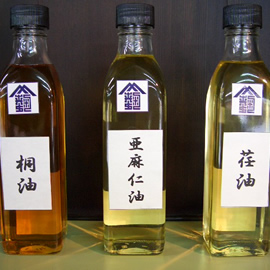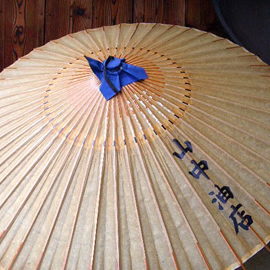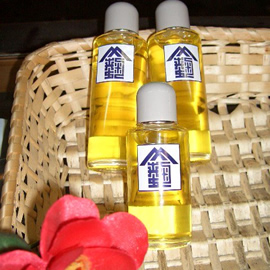 Firstly, when we speak of oil “drying”, we mean something different to when a damp object dries.
Firstly, when we speak of oil “drying”, we mean something different to when a damp object dries.
We refer to the process of oil polymerizing with oxygen by means of a chemical reaction, resulting in a solid form. So blowing oil with a hair-dryer does not achieve very much. Oils are classified into the three categories; drying oils, semi-drying oils and non-drying oils, depending on the speed at which they dry.
 The drying oil family includes perilla oil, linseed oil and tung oil used for wood coating, traditional Japanese paper lanterns and traditional Japanese paper umbrellas.
The drying oil family includes perilla oil, linseed oil and tung oil used for wood coating, traditional Japanese paper lanterns and traditional Japanese paper umbrellas.
 The semi-drying oil category includes rapeseed oil, which was mainly used for votive lighting in a bygone era and is now used predominantly for cooking.
The semi-drying oil category includes rapeseed oil, which was mainly used for votive lighting in a bygone era and is now used predominantly for cooking.
Camellia oil is a typical non-drying oil, indispensable in women’s haircare for many generations.
However, the drying speed differs depending on the level of natural antioxidants contained in the source plant, and the degree of refining, a process during which the smell, color and wax are removed to make the oil suitable for cooking.
 Our owner always says, “Modern houses are the best when they are just built, but traditional houses were made to improve over time, especially in terms of the wood used in construction. This shows us how well our predecessors understood the characteristics of oil. Year after year they would coat the wooden parts of a new house with rapeseed oil, a semi-drying oil which permeates through wood.
Our owner always says, “Modern houses are the best when they are just built, but traditional houses were made to improve over time, especially in terms of the wood used in construction. This shows us how well our predecessors understood the characteristics of oil. Year after year they would coat the wooden parts of a new house with rapeseed oil, a semi-drying oil which permeates through wood.
It was only after the rapeseed oil permeated the wood thoroughly enough to render it antiseptic and insecticidal that they started coating it with a drying-oil, such as linseed oil, as a finish, and the house only appeared nicer as time passed.
 As you pass some of the old townhouses, you can see their wooden pillars and cupboards emanating a healthy shine, which is the result of making good use of natural oil in combination with a daily ritual of dry-cloth polishing.
As you pass some of the old townhouses, you can see their wooden pillars and cupboards emanating a healthy shine, which is the result of making good use of natural oil in combination with a daily ritual of dry-cloth polishing.

